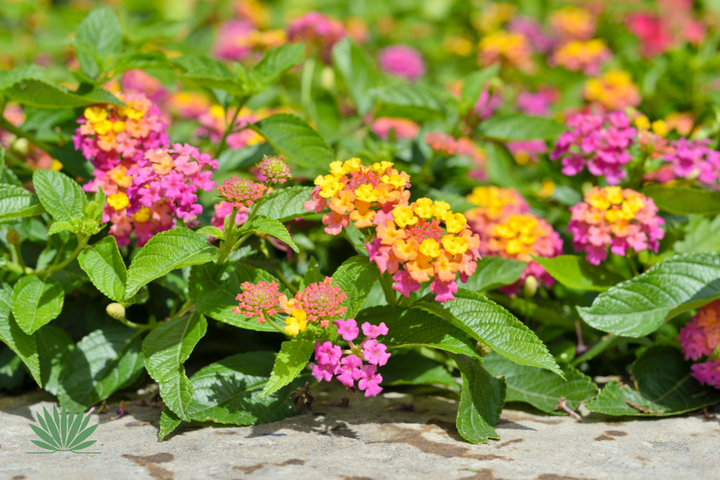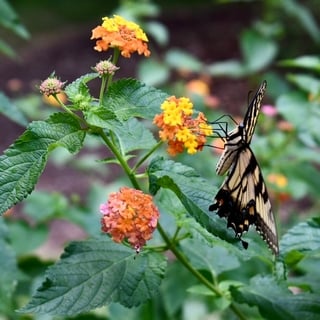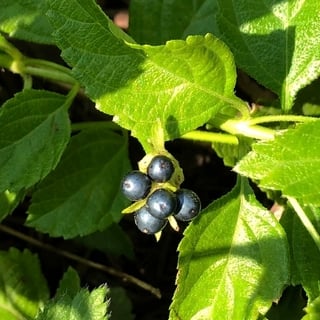Lantana is a desert-adapted shrubby ground cover that’s carpeted with charming multicolor flowers spring through fall. It’s one of the most popular desert landscape plants for good reason, but this ubiquitous ground cover has some downsides, too. Here’s everything you need to know about growing this festive “near native” of Mexico in this complete care guide.

Lantana (Lantana camara) is a delightful, low-maintenance ground cover that forms shrub-like mounds. Its slightly prickly leaves are dark green, and spring through fall plants are covered with flowers.
Lantana flowers form distinctive multicolor clusters that create a festive confetti effect. They come in a rainbow assortment of colors, depending on the variety.
Lantana is tougher than it looks. It tolerates the desert’s harshest conditions — full sun, poor soil, and drought.
Lantana attracts many important pollinators — bees, hummingbirds, moths, and butterflies. The berries, which are toxic to mammals, are enjoyed by birds.
Why I Like This Plant
- Explosion of flowers spring through fall
- Comes in a wide range of colors and sizes
- Grows fast
- Low water use, low maintenance, tough
- Attracts pollinators
- Deer, javelina, rabbit resistant

Things to Watch Out For
When you go shopping for lantana, don’t pick one just for the color of its flowers. Also take into consideration its form (trailing or shrub) and mature size.
All parts of lantana — leaves, flowers, and berries — are toxic to people, dogs, cats, and horses. The unripe green berries become less toxic as they ripen.

Many people don’t like lantana’s smell or irritating hairs. Some people find lantana mildly irritating, while others develop a full-blown allergic reaction when in contact with it.
Since lantana usually dies back from cold, in the winter it’s often not attractive and may resemble a pile of dead sticks.
It’s considered invasive throughout much of the southeastern US and in parts of Texas, California, and Arizona.
Optimal Growing Conditions
If you’re thinking of adding a lantana to your garden, you need to find a suitable place that will keep your plant healthy and looking good… while minimizing maintenance for you.
Here are the key factors to keep in mind.
Temperature
Lantana should be grown in USDA Hardiness Zones 9 – 11. Plants thrive in summer heat and survive temperatures down to 20℉. But once the temperature drops below freezing, plants will lose their leaves and flowers until the following spring.
Sun Exposure
Lantana thrives in full sun, even the reflected sun off of sidewalks, driveways, or walls. While it can be grown in part shade, the flowers are more colorful in full sun.
Size and Growth Rate
Lantana is a fast-growing ground cover. Its ultimate size depends on the cultivar, but most typically grow to be 2 to 3 feet tall and 4 feet wide.
Soil
Lantana is not picky about soil, and will grow in everything from sand to clay, provided it’s well-draining.
Pests & Diseases
The main pests to watch out for are whiteflies and lantana gall mites.
Whiteflies appear as tiny white specks on the underside of leaves or hovering around your plant. Whiteflies thrive in hot, dry weather and can be kept under control with a jet spray of hose water.
Caution!
Never spray lantanas with
insecticidal soap or dish detergent.
Either can kill lantanas.
Lantana gall mites (Aceria lantanae) are microscopic mites that only occur on lantana. They cause the plant to produce broccoli-like vegetative galls instead of flowers. It can be spread by wind, visiting insects, or infected garden tools.

If you see a lantana that looks like this, the best way to deal with it is to prune any abnormal growth as it appears. You may have to do this repeatedly. Be sure to disinfect your tools so you don’t spread it to other plants. (Learn the best way to disinfect garden tools here.)
Other Location Considerations
Since lantana can be irritating to touch and toxic, keep it where kids and dogs can’t get at it. It looks beautiful in pots or hanging baskets. People in colder climates often buy them as patio plants and treat them as annuals.
Since it loses its leaves, it’s not a good choice to plant near a pool.
No desert plant is completely “critter-proof” but deer, javelinas, and rabbits usually leave lantana alone, so you can plant it in your front yard or other unenclosed area.
Lantana:
The Essentials
| Common Name | Lantana |
| Scientific Name | Lantana camara |
| Origin | South & Central America, Mexico |
| Plant Type | Perennial ground cover |
| USDA Zones | Zones 9 – 11 |
| Cold Hardiness | To 20℉ |
| Flower Color | Various |
| Flower Season | Spring, summer, fall |
| Mature Size | 1-3’ high x 3-4’ wide |
| Growth Rate | Fast |
| Sun Tolerance | Full, part, reflected sun |
| Water Needs | Low |
| Pests & Diseases | Gall mite, white fly |
| Toxicity | All parts toxic, contact irritation |
| Wildlife | Attracts butterflies, hummingbirds, bees |
How to Plant
The rule of thumb when planting any ground cover in the desert is to dig a hole twice as wide as the root ball but no deeper. Amending the soil is not recommended. Counterintuitively, backfilling with the same native soil you just dug up helps your plant develop a stronger root system.
When to Plant
Since lantana is frost-sensitive, it’s generally recommended that you plant it in the spring after the danger of frost has passed. However, I’ve planted lantana in both the spring and the fall with equal success.
How to Care for Lantana
Whether you’ve recently planted a lantana or have an existing one in your yard, here’s how to take care of it to keep it healthy and looking its best.
How to Water
Once you’ve got your lantana in the ground, watering is your most immediate concern.
The University of Arizona recommends watering newly planted ground covers every 2 to 3 days for the first 2 to 4 weeks. After that, water once a week for the next two weeks, and then every 10 to 14 days after that.
During the winter, while it is dormant, it may not need any water, provided you’ve had winter rains. If not, water every 3 to 6 weeks.
How much water you should give your plant with each watering depends on the diameter of your plant and will change as it grows. You can use this chart as a guide.
| 1 foot diameter | .5 gallons |
| 2 feet diameter | 2 gallons |
| 3 feet diameter | 3.5 gallons |
| 4 feet diameter | 5 gallons |
Should You Fertilize?
While most lantanas survive quite happily without fertilizer, the Arizona-Sonora Desert Museum recommends fertilizing lantana twice per year, in the early spring and early fall, to ensure optimal growth and blooms.
How to Prune
Lantana benefits from a hard prune in the spring after the last frost date. Don’t be afraid to take your plant all the way down to the ground. It grows vigorously and will quickly grow back to its former size.
During its growing season, you can lightly prune anytime to control its size or shape.
Lantana Cultivars to Consider
There’s a multitude of lantana cultivars to choose from that have different flower colors, forms, and sizes. Some offer additional features such as being sterile or particularly attractive to butterflies. Here’s a handful of cultivars that have proven themselves winners in desert landscapes:
- ‘Dallas Red‘ – true red flowers, shrub-like (3’x4’)
- ‘New Gold‘ – gold flowers, spreading (2’x4’), sterile, butterfly magnet
- ‘Irene’ – bright pink & yellow flowers, spreading (2’x5′)
- ‘Radiation’ – orange flowers, large shrub-like (5’x5′)
You may have seen purple or white lantanas that grow low to the ground and are more likely to stay green, and even flower, all winter. These are trailing lantanas that belong to a different species — Lantana montevidensis.
Is Lantana Invasive?
Having lived in Florida for many years, I was aware that lantana is considered invasive throughout much of the hot, humid southeastern US. But I was shocked to learn that lantana is on the list of the world’s 100 worst invasive species! 😮
It’s considered an invasive species in some western states including California, Texas, and Arizona.
In its native habitat, lantana grows in moist areas. For this reason, it probably won’t become a big nuisance in the southwest, however invasive pockets have been reported in Maricopa and Pima Counties (Phoenix and Tucson, respectively) and in Pipe Organ National Monument.
If this is a concern for you, or you live near water, consider planting one of the sterile varieties such as ‘New Gold,’ ‘Miss Huff,’ ‘Lemon Swirl,’ and members of the ‘Patriot’ series.
Plant Lover Facts
Lantana also goes by the common names shrub verbena, largeleaf lantana, and bigleaf lantana. It is sometimes referred to as bush lantana to distinguish it from trailing lantana.
It has a large native range that extends from the northern half of South America, through Central America, and into Mexico. While generally not considered a native plant, its natural range does include parts of the Sonoran Desert in Mexico, making it a “near native.”
You may be wondering how lantana can be native or “near native” and potentially invasive. These two seemingly contradictory statements can be true, since a defining feature of the Sonoran Desert is its diversity. It contains a network of ecosystems. A plant that is native to one of these ecosystems can become invasive in another.
Did you enjoy this article?
Sign up for our weekly newsletter
where you’ll find more great info on creating &
maintaining a beautiful, carefree desert landscape.
Author Bio
Deane Alban is the creator of Southwest Gardener. She is a science writer with a bachelor’s degree in botany from the University of South Florida. Gardening is her lifelong passion. She’s been gardening in Tucson for over 15 years.

